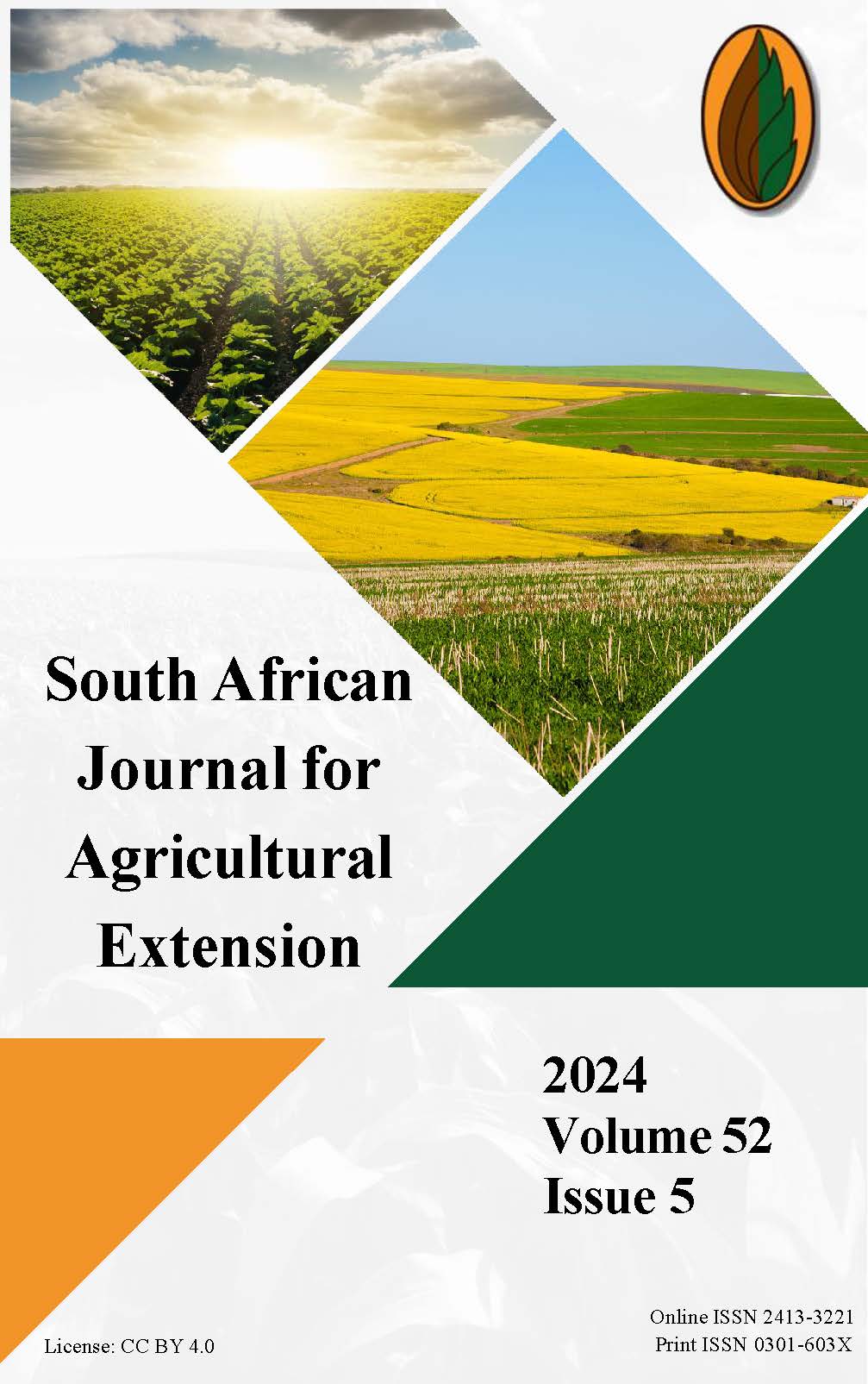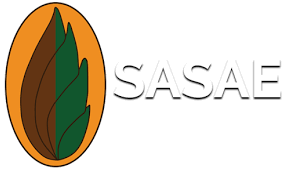Benefits of Herding on Communal Rangelands in Free State Province, South Africa
DOI:
https://doi.org/10.17159/2413-3221/2024/v52n5a14651Keywords:
Benefits of Herding, Communal Rangeland, Herd PerformanceAbstract
This study used survey data to measure the benefits of paid herding for small stockholders on the communal rangelands of the eastern Free State. Extensionists can recommend herding to their clients because it mitigated the worst of a recent drought by controlling intermediate consumption and facilitating better recruitment. However, the practice did not impact the size or composition of livestock losses. In drought, livestock holders prioritised off-take over accumulation and selectively shed male animals. Off-take was directed to sales rather than to home consumption. Herding affected the cost of production, with herders saving more than their wages on purchased feed and remedies but not enough to make their herds profitable.
Downloads
References
ABEYGUNAWARDENA, H. & DEMATAWEWA, C.M.B., 2004. Pre-pubertal and postpartum anestrus in tropical Zebu cattle. Anim. Reprod. Sci., 82: 373-387. DOI: https://doi.org/10.1016/j.anireprosci.2004.05.006
ALIBER, M. & MDODA, L., 2015. The direct and indirect economic contribution of small-scale black agriculture in South Africa. Agrekon., 54(2): 8-37. DOI: https://doi.org/10.1080/03031853.2015.1065187
ALLSOPP, N., LAURENT, C., DEBEAUDOIN, L.M. & SAMUELS, M.I., 2007. Environmental perceptions and practices of livestock keepers on the Namaqualand Commons challenge conventional rangeland management. J. Arid Environ., 70(4): 740-754. DOI: https://doi.org/10.1016/j.jaridenv.2006.11.005
BERNSTEIN, H., 2013. Commercial Agriculture in South Africa since 1994: 'Natural, Simply Capitalism'. J. Agrar. Change., 13(1): 23-46. DOI: https://doi.org/10.1111/joac.12011
CHONCO, J.M., 2009. Factors influencing choices of grazing lands made by livestock keepers in Enhlanokhombe in Ukhahlamba (Drakensberg). Unpublished doctoral thesis, University of KwaZulu-Natal, Pietermaritzburg, South Africa.
CONRADIE, B. & NATTRASS, N., 2017. The robustness of self-report data on predation: A comparison of two Karoo surveys. Afr. J. Agric. Resour. Econom., 12(3): 217-229.
CONRADIE, B. & LANDMAN, A., 2015. Wool versus mutton in extensive grazing areas. S Afr. Jnl. Agric. Ext., 43(1): 22-31.
DEPARTMENT OF AGRICULTURE LAND REFORM AND RURAL DEVELOPMENT (DALRRD)., 2021. Abstract of Agricultural Statistics. Pretoria: Directorate Statistics and Economic Analysis.
HARDIN, G., 1968. The tragedy of the commons: the population problem has no technical solution; it requires a fundamental extension in morality. Science., 162(3859): 1243-1248. DOI: https://doi.org/10.1126/science.162.3859.1243
HORNBY, D. & COUSINS, B., 2019. "Reproducing the social": Contradictory interconnections between land, cattle production and household relations in the Besters Land Reform Project, South Africa. Anthropol. South. Afr., 42(3): 202-216. DOI: https://doi.org/10.1080/23323256.2019.1653206
MAPIYE, C., CHIMONYO, M. & DZAMA, K., 2009. Seasonal dynamics, production potential and efficiency of cattle in the sweet and sour communal rangelands in South Africa. J. Arid Environ., 73(4-5): 529-536. DOI: https://doi.org/10.1016/j.jaridenv.2009.01.003
MÜLLER, F.L., IGSHAAN SAMUELS, M., CUPIDO, C.F., SWARTS, M.B., AMARY, N.M., HATTAS, D., MORRIS, C., CYSTER, L.F. & STEPHEN BOATWRIGHT, J., 2019. The impacts of season and livestock management strategy on the quality of diets selected by goats and sheep in the semi-arid rangelands of Namaqualand, South Africa. Afr. J. Range Forage Sci., 36(2): 105-114. DOI: https://doi.org/10.2989/10220119.2018.1552622
NQENO, N., CHIMONYO, M. & MAPIYE, C., 2011. Farmers' perceptions of the causes of low reproductive performance in cows kept under low-input communal production systems in South Africa. Trop. Anim. Health Prod., 43(2): 315-321. DOI: https://doi.org/10.1007/s11250-010-9691-2
NYAM, Y.S., 2017. A metafrontier analysis of sheep production in the N8 development corridor. Unpublished doctoral thesis, Free State University, Bloemfontein, South Africa.
OSTROM, E., 2009. A general framework for analyzing sustainability of social-ecological systems. Science., 325(5939): 419-422. DOI: https://doi.org/10.1126/science.1172133
ROHDE, R.F. & HOFFMAN, M.T., 2008. One hundred years of separation: The historical ecology of a South African 'coloured reserve'. Africa., 78(2): 189-222. DOI: https://doi.org/10.3366/E0001972008000132
SALOMON, M., CUPIDO, C. & SAMUELS, I., 2013. The good shepherd: Remedying the fencing syndrome. Afr. J. Range Forage Sci., 30(1-2): 71-75. DOI: https://doi.org/10.2989/10220119.2013.781064
SAMUELS, I.M., ALLSOPP, N. & HOFFMAN, M.T., 2021. Changes in pastoral mobility in a semi-arid montane region of South Africa: The role of policy and legislation. Afr. J. Range Forage Sci., 38(1): 1-13. DOI: https://doi.org/10.2989/10220119.2020.1861096
SAMUELS, M.I., SWARTS, M., SCHROEDER, A., NTOMBELA, K. & CUPIDO, C., 2018. Through the lens of a herder: Insights into landscape ethno-ecological knowledge on rangelands in Namaqualand. Anthropol. South. Afr., 41(2): 136-152. DOI: https://doi.org/10.1080/23323256.2018.1462091
SAMUELS, M.I., ALLSOPP, N. & KNIGHT, R.S., 2007. Patterns of resource use by livestock during and after drought on the commons of Namaqualand, South Africa. J. Arid Environ., 70(4): 728-739. DOI: https://doi.org/10.1016/j.jaridenv.2006.11.006
SCHURCH, M.P., MCMANUS, J., GOETS, S., PARDO, L.E., GAYNOR, D., SAMUELS, I., CUPIDO, C., COULDRIDGE, V. & SMUTS, B., 2021. Wildlife-friendly livestock management promotes mammalian biodiversity recovery on a semi-arid Karoo farm in South Africa. Front. Conserv. Sci., 2: 652415. DOI: https://doi.org/10.3389/fcosc.2021.652415
STRAUSS, A.J., AVENANT, N.L. & DE WAAL, H.O., 2021. The impact of predation on Merino and Dorper sheep flocks in the central Free State Province, South Africa. Indago., 37: 43-53. DOI: https://doi.org/10.38140/00679208/INDAGO.V37.A7
TODD, S.W. & HOFFMAN, M.T., 1999. A fence-line contrast reveals effects of heavy grazing on plant diversity and community composition in Namaqualand, South Africa. Plant Ecol., 142(1): 169-178. DOI: https://doi.org/10.1023/A:1009810008982
TSOTETSI, A.M. & MBATI, P.A., 2003. Parasitic helminths of veterinary importance in cattle, sheep and goats on communal farms in the northeastern Free State, South Africa. J S Afr Vet Assoc., 74(2): 45-48. DOI: https://doi.org/10.4102/jsava.v74i2.503
Downloads
Published
Issue
Section
License
Copyright (c) 2024 B. Conradie, N. Matthews, Y. Bahta

This work is licensed under a Creative Commons Attribution 4.0 International License.








.png)